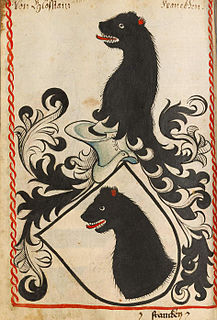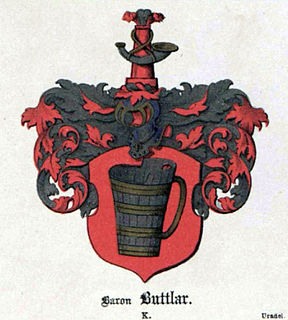
Heinrich von Bibra, Prince-Bishop, Prince-Abbot of Fulda (1711–1788) was Prince-Bishop and Prince-Abbot from 1759 to 1788. As part his role as Prince-Abbot of Fulda, he had the additional role as Archchancellor (Erzkanzler) of the Holy Roman Empress.

The House of Bibra was one of the leading Uradel families in Franconia and present day Thuringia from the mid-15th century to about 1600. Later on the family rose from Reichsritter to Reichsfreiherr. After the Holy Roman Empire dissolved, they were made ‘’Freiherr’‘ (Barons) of Bavaria and Bohemia.

August Ludwig Karl Georg Friedrich Freiherr von Bibra was director of the business affairs of Hermann, prince of Wied. He became general manager of the Adelsverein, or Verein zum Schutze Deutscher Einwanderer in Texas.
Christoph Moritz Max Freiherr von Beschwitz, Lord of the Castle of Arnsdorf in the Kingdom of Saxony, was a German Nobleman, son of Heinrich Moritz Max Freiherr von Beschwitz and wife Alexandra Emilie Caroline Eugenie Henriette Adele Gräfin Zedtwitz von Moraván und Duppau.

The House of Guttenberg is a prominent Franconian noble family. It traces its origins back to 1149 with a Gundeloh von Blassenberg (Plassenberg), though the first mention in a document is dated 1158. The name Guttenberg is derived from Guttenberg in present-day Bavaria, and it was adopted by a Heinrich von Blassenberg around 1310.

Karl Abraham Freiherr von Zedlitz und Leipe was a Prussian minister of education who was instrumental in establishing mandatory education in Prussia, which served as a model for the public education system in the United States.
The House von und zu Manndorff zu Pfannhofen und Wissenau is the name of an ancient Austrian noble family, more specifically the Uradel. They are among the oldest Carinthian noble families still in existence today.

Müllenheim was an old Strasbourg noble family. The noblemen, knights or Freiherren of Müllenheim belonged to the Alsatian old nobility. The family, which is still thriving today, can be divided into five existing main branches, all of which descend from the "Heinrich Line" or the "Müllenheim zu Rechberg". On the one hand, there are the Catholic "Barons de Mullenheim", who received the French title of nobility in 1773, and the Protestant branches, including the "Freiherrn von Müllenheim-Rechberg", which were elevated to Prussian rank in 1886, plus the untitled branches of the "Müllenheim", whose common ancestors dropped the nobility title "von" in the 18th century, probably for pietistic reasons. These three Silesian branches can in turn be subdivided into those that are now based in the Rhineland or around Brunswick, and those incorrectly written as "Mühlenheim".

Jean de Forcade de Biaix, aka Jean de Forcade, Marquis de Biaix, aka Jean-Quirin de Forcade de Biaix, aka Jean Quérin von Forcade, Herr von Biaix, aka Johann Querin de Forcade, Herr zu Biaix, aka Johann Quirin von Forkade de Biaix was a Huguenot, a descendant of the noble family of Forcade and Lieutenant General in the service of the Kingdom of Prussia. He was the Regimentschef of the 23rd Prussian Infantry Regiment, Commandant of the Royal Residence in Berlin, Gouverneur militaire of Berlin, a Knight of the Order of the Black Eagle a member of King Frederick I of Prussia's "Tobacco Collegium". and president of the Grand Directoire 1718–1729, the deliberative and decision-making body responsible for all Huguenot affairs in the kingdom.
Friedrich Heinrich Ferdinand Leopold von Forcade de Biaix, aka Heinrich Friedrich Ferdinand Leopold von Forcade de Biaix, aka Friedrich Heinrich Ferdinand Leopold Marquis de Forcade de Biaix, was a Royal Prussian lieutenant colonel. He served in the Prussian Army from 1761-1793. His last command was as Commanding Officer of the 10th Prussian Fusilier Battalion, with which he served in the Rhine Campaigns of 1791, where he was awarded the Kingdom of Prussia's highest military order of merit for heroism, Knight of the Order of Pour le Mérite (1791). He left the Prussian Army after 32 years of service in 1793 as the result of invalidity. At the time of his death, he was the owner of Schleibitz Manor, near Oels, Silesia.
This is the family tree of the Austrian Von Graben family. Originally from Carniola, the House Von Graben is an apparent branch of the House of Meinhardin. The family went on to rule some Carinthian, Tyrolian, East Tyrols, modern Italian, Styrian, and Gorizian districts as Burggrafen and Lords (Herren) from the early Middle Ages until the 16th–17th century.

Arnold Christoph von Waldow (1672–1734) was Lord of the Manor on Hammer and Költschen, Lieutenant General, Governor of Breslau and Knight of the Black Eagle. Born on 15 April 1672 in Stolzenfelde, Neumark, he was the son of the Brandenburg Captain Christian Sigismund von Waldow (1650–1707) and Katharina von Sydow (1651–1702). His brother Friedrich Siegmund von Waldow (1682–1743) was a Prussian general.

Waldow or Waldau, is the name of a Bavarian noble family. The family belonged to the nobility in Nordgau. Originally a Prussian family, they became influential in Brandenburg in the 14th century. The earliest known ancestor is Knight Hentzlinus de Waldow. The family acquired land in Neumark, Meissen, Silesia and Pomerania, where they came to prominence and prestige that they retained until the Second World War.

Christoph Ernst Friedrich von Forcade de Biaix was a German Rittergut owner, Appellate Court Judge in Hamm, Supreme Court Judge in Berlin and Member of parliament in the German Reichstag.

The House of Seckendorff is the name of an old and prolific Franconian noble family. According to historian Werner Wagenhöfer, the Seckendorff family is the most researched family of the low nobility in Franconia along with the Guttenberg and Bibra families.

The House of Egloffstein is an ancient Franconian aristocratic family (Uradel) with an eponymous family home in the hill region of Franconian Switzerland in the Bavarian province of Upper Franconia. The family first appears in the records in 1187 with a Heinrich genannt Stuchs who is also the progenitor. The house belongs to the brotherhood of Franconian Imperial Knights. Egloffstein Castle and Kunreuth Castle are to this day owned by the family.

Schloss Hundshaupten is a quadrangular castle in the village of Hundshaupten in the municipality of Egloffstein in the German county of Forchheim.

The House of Buttlar is the name of an old Upper Franconian-Hessian noble family. The lords of Buttlar originate from the ancient nobility of Buchonia. Branches of the family also reached Westphalia, Saxony, Prussia, Curonia, France, Poland, Russia and Hungary, and remain partly to this day. The Buttlar and Treusch von Buttlar families of Hessen has since 1660 belonged to the Old Hessian Knighthood, the oldest foundation in Hessen.





















